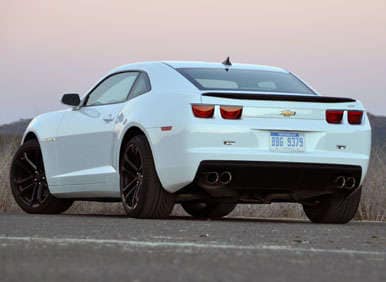Recent Articles
Popular Makes
Body Types
2013 Chevrolet Camaro SS 1LE Road Test and Review
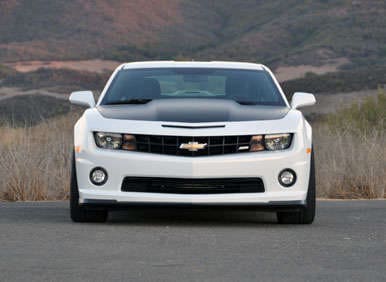
Chevrolet first offered a 1LE option package for the 1988 model year, a time when Terence Trent D’Arby was popular on the radio, a furry puppet named Alf was a beloved TV star, and Eddie Murphy was still funny. Inspired by Chevrolet’s involvement in Pro-Am road racing, the 1LE Package was intended for Camaro buyers who raced their cars in SCCA Showroom Stock competition, and it added a number of performance upgrades to IROC-Z models headed for the track.
Now, 25 years later, the 1LE option package returns, offered on the Camaro SS and providing transmission, suspension, and styling enhancements aimed at making the car race-ready for SCCA Touring Car competition. I grabbed the keys to a Summit White example and proceeded to, umm, cart my kids around in it.
Really, I wish the following pages regaled readers with tales of burnt rubber and triple-digit speed, but they don’t. Sorry.
2013 Chevrolet Camaro SS 1LE Review: Pricing and Trim Levels
Check the box for the SS 1LE Package when ordering a new 2013 Chevy Camaro SS, and you’ll spend $3,500 to obtain what Chevrolet calls “a competition ready package” for track enthusiasts. Offered only with a manual transmission, the 1LE Package contains several upgrades from the Camaro ZL1 and a unique look that distances the Camaro SS 1LE from other models.
The Camaro 1LE Package is pretty simple, actually. It includes an exclusive 6-speed manual gearbox with a 3.91 final-drive axle ratio and an air-to-liquid cooling system, staggered width 20-inch forged aluminum wheels in a gloss black finish, and a set of amazing 285/35ZR20 Goodyear Eagle Supercar G:2 performance tires. The 1LE Package also adds a Performance Ride and Handling suspension with a front strut tower brace, monotube rear shocks, and larger stabilizer bars.
From a design standpoint, the SS 1LE Package adds a matte-black hood to reduce glare and reflections, a matte-black front chin spoiler, and a matte-black rear spoiler. Inside, the Camaro 1LE gets the same flat-bottomed steering wheel and short-throw shifter as the Camaro ZL1, each wrapped in microfiber suede.
Add the 1LE Package to a base Camaro 1SS, and you’ll roll off the showroom floor for as little as $37,035 including the $900 destination charge. Get it with a Camaro 2SS, which includes leather seats, a head-up display, a Boston Acoustics premium sound system with a USB port, an auxiliary gauge cluster, a reversing camera, and rear parking assist sensors, and the out-the-door price is a minimum of $40,535 including destination.
You can get a Camaro SS 1LE in any color, but Chevrolet stipulates a black interior. An automatic transmission is verboten, but otherwise the SS 1LE can be upgraded with a navigation system, a power sunroof, and a dual-mode performance exhaust system. Additional options for the base Camaro SS include a premium sound system (1SS), a reversing camera, and rear parking assist sensors.
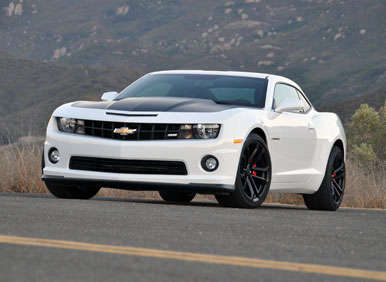
2013 Chevrolet Camaro SS 1LE Review: What It's Up Against
Given its membership as one of a trifecta of American pony cars and its 426-horsepower engine, the 2013 Camaro SS 1LE’s natural competitor is the 420-horsepower, 2013 Ford Mustang GT equipped with the GT Track Package. A Mustang so-equipped includes an upgraded radiator and engine cooler, performance friction brake pads, a Torsen limited-slip rear differential from the Boss 302 model, a Brembo braking system, and 19-inch aluminum wheels with summer performance tires. Add Recaro seats, and the Mustang runs $35,185 including a $795 destination charge.
In terms of horsepower, the Chevy Camaro SS 1LE splits the difference between a 375-horsepower Dodge Challenger R/T ($30,990) and a 425-horsepower Dodge Challenger SRT8 ($45,420). Add a Super Track Pak to a base Challenger R/T, which includes a sport suspension, sport-tuned steering, performance brakes, and 20-inch aluminum wheels wrapped in P245/45ZR20 summer performance tires, and the price of the heavier and less powerful Challenger is a relative bargain at $32,580 including the $995 destination charge.
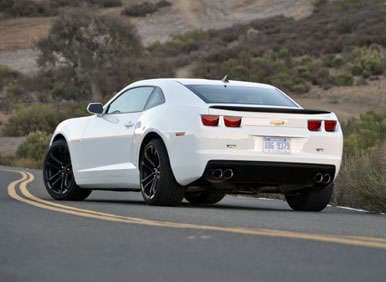
2013 Chevrolet Camaro SS 1LE Review: Exterior
- SS 1LE Package adds matte-black detailing and Goodyear Eagle Supercar G:2 performance tires
- New Blue Ray Metallic Color
Among the members of the American pony car trifecta, and in your author’s humble opinion, the retro-mod Chevy Camaro is the best looking of the trio.
Unlike the Dodge Challenger, the Camaro looks properly proportioned on its platform, and whereas Dodge elects to style the Challenger in as close adherence as possible to the original 1970 model, the Chevy modernizes key design cues from the 1969 Camaro. Sadly, Ford’s retro Mustang has aged to the point where designers are employing gimmicks like hood vents and full-width smoked taillight panels to keep the car looking somewhat fresh until a redesigned ‘Stale – I mean, ‘Stang – arrives for 2015.
As for the Camaro, I particularly like the 2013 Camaro SS 1LE model’s matte-black hood and trim treatment. And while I’ve never been a fan of black wheels, those on the Camaro 1LE tie the car’s track-ready appearance together in a way the standard Camaro SS or ZL1 wheels never could.
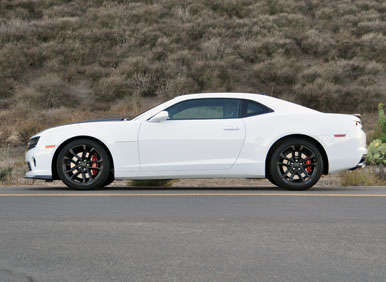
2013 Chevrolet Camaro SS 1LE Review: Interior
- SS 1LE Package adds ZL1-sourced flat-bottomed steering wheel and short-throw shifter
- Standard Chevrolet MyLink technology
- Optional touchscreen navigation system
When the Camaro’s retro-themed cabin debuted for 2010, it did the 1969 Camaro proud with square-shaped gauge surrounds, a three-spoke steering wheel with as small a center hub as possible, and an optional 4-gauge auxiliary cluster forward of the shifter. Today, the Camaro has a more conventional cabin appearance thanks to its new color touchscreen radio with MyLink technology and a more conventional steering wheel that appears as though its been lifted out of a Malibu.
The result is that the 2013 Camaro has lost some of its retro charm, which only serves to draw attention to some of the inexpensive materials with which the cabin is constructed. It doesn’t help that when choosing the Camaro SS with the 1LE Package, you can get your car’s interior in any color you want as long as its black, which also serves to magnify cost cutting in some areas.
The base Camaro SS model includes cloth seats, while the 2SS 1LE model has leather upholstery. The front seats offer power adjustment, including for height, and are extremely comfortable. The Camaro provides more headroom than you might expect given its rakish roofline, and is the kind of car you could drive all day long without suffering discomfort.
That’s not true of the back seat, which is utterly inhospitable for full-size people. I crammed my six-foot, 250-lb. self into the back seat and found my head crammed into the headliner. Powering the driver’s seat forward provided the only way to fit my legs and feet into the back seat. In this respect, the Dodge Challenger is a far superior choice in the segment.
Entry and exit are also challenging, especially given the tight parking spaces in many Los Angeles area locations. The Camaro’s doors are long and heavy, and they need to swing fairly wide for the front seat occupants to exit the vehicle. They also make loading children into the back seat very difficult.
Yep, I used the Camaro SS 1LE as a family car, hauling a 4-year-old and a 2-year-old in forward-facing child safety seats. The Camaro’s front seatbacks offer a quick-release mechanism, but to make enough room to squeeze past the roof pillar to securely buckle little ones in for the ride, the front seats need to be powered forward. Which takes a long time.
The Camaro’s 11.3 cu.-ft. trunk accepted our smaller stroller without trouble. The trunk liftover height is high, and the opening is fairly small. Again, a Dodge Challenger puts the Camaro to shame in this regard. Clearly, “practicality” is not the Camaro’s middle name.
As for Chevy MyLink, I found the system easy to use. At first. After initial success pairing an iPhone and streaming music, the system appeared to be stuck on “pause” during subsequent trips in the car, and my family was unable to successfully stream music after that first try. Also, during phone calls, the Camaro’s booming exhaust note made it hard for people on the other end of the conversation to hear what my wife was saying.
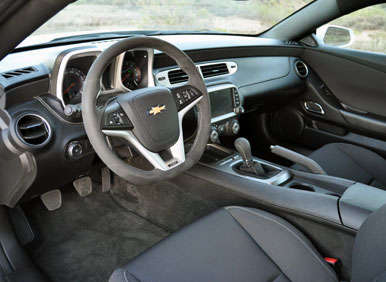
2013 Chevrolet Camaro SS 1LE Review: Matters of Safety
- Standard hill start assist with manual transmission
According to the National Highway Traffic Safety Administration (NHTSA), the 2013 Chevrolet Camaro is a safe car, boasting a 5-Star overall crash-test rating. The Insurance Institute for Highway Safety (IIHS) has not evaluated the Camaro’s crashworthiness.
The impressive NHTSA rating covers the Camaro’s structural protection, but what about the safety features that help to avoid an accident in the first place? Standard safety equipment for the Camaro SS includes six airbags, a traction and stability control system with Competitive/Sport mode, and 4-wheel-disc brakes with Brembo front calipers.
Chevrolet also includes a free 6-month trial of OnStar service, which includes Automatic Crash Notification. If the car’s airbags deploy, and OnStar operator contacts the Camaro to check on passengers and can dispatch rescue personnel to the car’s exact location, helping to speed rescue.
The only safety-related options offered for the Camaro 1SS are a reversing camera and rear parking assist sensors, both of which are highly recommended. These come standard on the Camaro 2SS model.
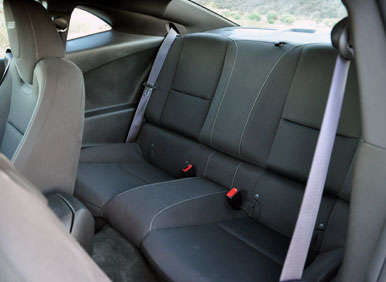
2013 Chevrolet Camaro SS 1LE Review: Powertrain
- SS 1LE Package adds 6-speed manual gearbox with a 3.91 final-drive axle ratio and an air-to-liquid cooling system, Performance Ride and Handling suspension, front strut tower brace
- Standard electric steering for SS models
- Optional dual-mode exhaust system with manual transmission
Equipped with a 6.2-liter V-8 engine making 426 horsepower and 420 lb.-ft. of torque, the Camaro SS 1LE does not offer additional horsepower or torque over the standard Camaro SS. Rather, the mechanical upgrades pertain to the transmission, suspension, wheels, and tires.
The 1LE Package adds an exclusive 6-speed manual gearbox to the Camaro SS, one offering a 3.91 final-drive axle ratio and an air-to-liquid cooling system to ensure durability on track days. The staggered 20-inch forged aluminum wheels are lifted directly from the high-performance Camaro ZL1, dipped in a gloss black finish and wrapped in 285/35ZR20 Goodyear Eagle Supercar G:2 performance tires. A Performance Ride and Handling suspension is also included with this package, and it includes monotube rear shock absorbers and larger front and rear stabilizer bars. A front strut tower brace caps off the hardware modifications.
Not that you’re particularly concerned about fuel economy when shopping for a Camaro SS 1LE, but its worth noting that the EPA expects this model to get 16 mpg in the city, 24 mpg on the highway, and 19 mpg in combined driving. I averaged 18 mpg, traveling primarily on the highway.
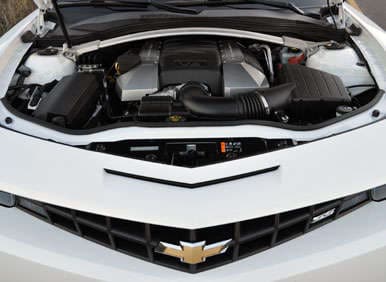
2013 Chevrolet Camaro SS 1LE Review: How It Drives
A Chevy Camaro SS 1LE is simply too wide, too long, and too hard to see out of to be much fun on a twisty two lane road. It’s also difficult to drive in urban areas due to poor outward visibility and a front spoiler susceptible to damage. As an open road cruiser or, and this is pure conjecture based on our observations about the SS 1LE’s handling, a track-day bruiser, this Camaro is impressive.
The Camaro SS powertrain is terrific, and with the optional dual-mode exhaust system the car is loud with lots of snap, crackle and pop when you let off the gas at higher engine revs. My 4-year-old daughter, a huge fan of the Disney Pixar movie “Cars,” loved it, exclaiming from the back seat that my family was going really fast when we really weren’t.
She makes a credible observation about the Camaro – it feels like you’re going faster than you are, because of the exhaust note and because it’s so dang hard to see out of this car. The frameless rearview mirror helps improve visibility, but my wife thought the red and blue OnStar buttons made it appear, in the driver’s peripheral vision, that a patrol car with the gumballs lit was approaching from behind.
The Camaro SS 1LE is fairly easy to launch, and includes a hill hold assist system for getting started on a hill. The clutch feels substantial but not heavy, and the close-ratio gearbox with the Camaro ZL1’s short-throw shifter offers surprisingly precise engagement for a traditional American muscle car.
The Camaro’s chassis is rock solid, and the 1LE Package’s suspension tuning is perfection. Rolling down the Ronald Reagan Freeway near Simi Valley, Calif., the Camaro SS 1LE soaked up the sectioned concrete middle traffic lane like a 1970s Cadillac. Obviously, this comfortable ride quality comes without compromise in terms of handling. Grip is extraordinary, thanks to those massive Goodyear Eagle Supercar G:2 tires.
If I have complaints, they pertain to the Camaro SS 1LE’s steering and braking components. The electric steering is new for 2013, and lifted directly from the Camaro ZL1. While the previous hydraulic steering wasn’t great, this new electric setup could use greater effort levels off-center and at higher speeds to add a sense of solidity and surety to the proceedings. I also detected a ghostly oscillation unrelated to the street surface when traversing changes in road camber and crown.
As for the Camaro SS 1LE’s brake pedal response, it feels fine under normal driving conditions. At speed, however, I thought our test sample’s pedal lacked bite, the exact opposite of what a track-tuned car ought to feel like. When running hard, there’s too much pedal travel and then, when the brakes do engage, they feel as though they’re suffering from fade. A panic stop at the conclusion of a mountainous test run revealed that this particular Camaro suffered no shortage of stopping power, so I’m left to conclude that pedal calibration is responsible for my dissatisfaction with underfoot feel and response.
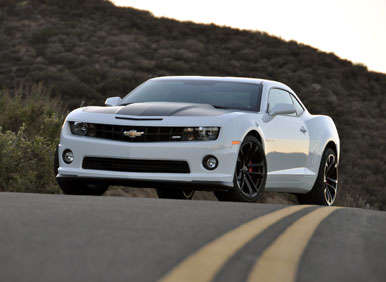
2013 Chevrolet Camaro SS 1LE Review: Final Thoughts
The 2013 Chevy Camaro SS 1LE would be a fun and capable track car, where kindly school-zone crossing guards don’t disappear behind the mature Sequoia trees masquerading as the Camaro’s windshield pillars, where keeping the wide Camaro planted between the yellow and white lines on narrow mountain roads doesn’t produce heart palpitations, where the Camaro’s front splitter isn’t constantly trying to commit suicide on parking blocks and driveway aprons, where men with AndroGel prescriptions aren’t attempting to race the Camaro from every street light, and where the police aren’t looking for any good reason to yank the Camaro to the curb.
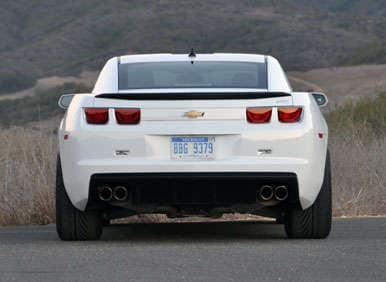
2013 Chevrolet Camaro SS 1LE Review: Pros and Cons
Pros:
- Speed, and more speed
- Snap, crackle and pop exhaust note
- Surprise-and-delight manual gearbox
- Outstanding suspension tuning
- Incredible tire grip
- Comfortable front seats
- Attractive exterior design and matte-black detailing
Cons:
- Restricted outward visibility
- Light electric steering
- Mushy brake pedal feel
- Cramped back seat
- Tight trunk
- Difficult entry and exit
- 18 mpg despite lots of highway driving
Chevrolet provided the vehicle for this review
2013 Chevrolet Camaro SS 1LE Photos by Christian Wardlaw
